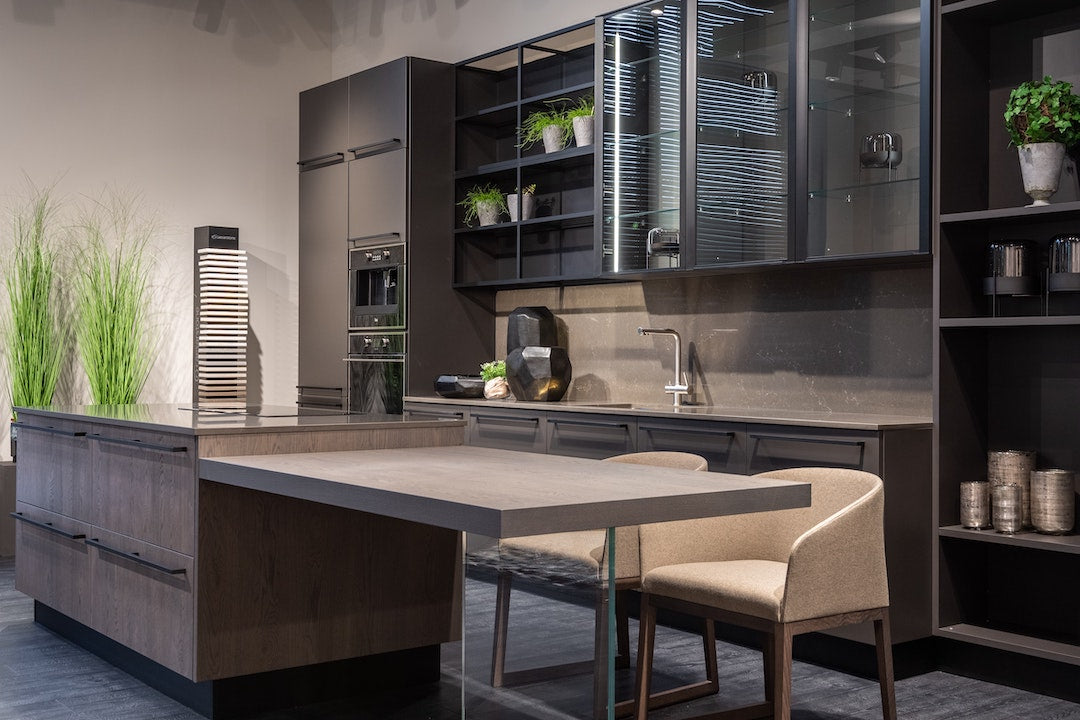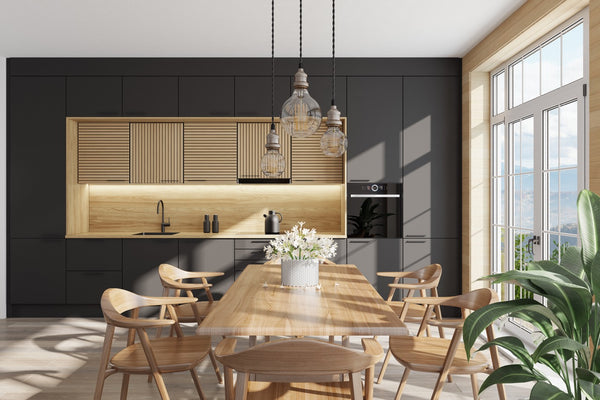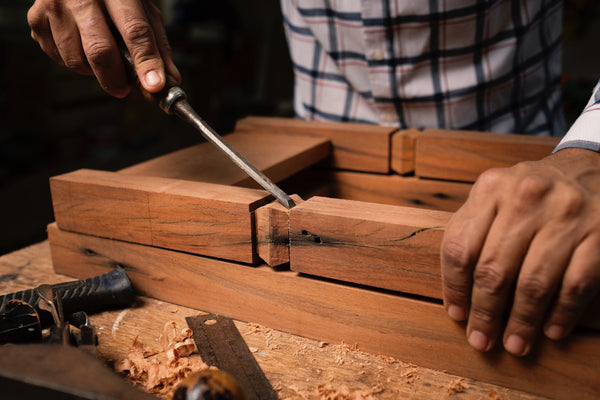The Evolution of the Kitchen in 5 Major Movements

It is easy to look at the way we live our lives now and think that is more or less how it has always been. In kitchen design, this is certainly not the case. Below we will look at five major periods that formed the modern kitchen.
(above photo by roam in color on Unsplash)
Pre-1830

The oldest way humanity has seen fit to cook food is over an open fire. This method of cooking was still being used en mass up until 1830 and continued to be an acceptable way to cook for decades after. Not all cooking was done inside the home, especially when the weather was hot, but all cooking that was done in the home, was done at the hearth. The hearth served the dual purpose of providing heat for the home, and a means to cook a meal. The fireplace which held the hearth was in a centrally located part of the home and the room that contained it served multiple purposes. It was used as a cooking area, a living room, a bathing area and even a bedroom if need. Because of the diverse use of the hearth and the different aspects of home life that revolved around it, there was no room designated as a kitchen in this era.
(above photo of traditional hearth from the public domain)
1830-1900

Although first invented by Benjamin Franklin in 1740, cookstoves began their popular rise in the 1830’s. Prior to that, they were reserved for the rich and the affluent as they were cost prohibitive to the average American family. With new ways to process steel and iron as well as a developed trade of skilled artisans, cookstoves became more accessible to the American populace and became the backbone of the first, semi-standardized kitchen. With their mass accessibility, many families were able to leave behind hot and dangerous hearth cooking and designate the fireplace to what became the 'living room'. Cookstoves became the centerpiece of a new room called the kitchen.
(The above photo is from a catalogue printed in the year 1884 and is from the public domain)
1900-1925

The early 1900’s was a big time for urban development. It was in this time that cities began connecting residential homes to the city water supply which in turn gave homes indoor plumbing. In this period, many urban homes were also connected to the city’s electrical grid. Both of these advancements had a large influence on kitchen design. Kitchens were now able to hade sinks with water faucets, not just wash basins. Stoves could both be run on gas and electric power. Gone were the days of huge, dirty and clunky cookstoves that could only operate on wood and messy charcoal. In their place came sleeker more modern stoves that were easier to clean, more compact and much more efficient.
(above photo is from the public domain)
1926 – 1950's

The modern kitchen was born in Germany in the 1920’s. At this time in history Frankfurt Germany was experiencing an affordable housing crisis. Ernst May, a prominent German architect, was the man tasked to find a solution and he was commissioned by the city of Frankfurt to create 10,000 affordable housing units. Space was limited, and the responsibility was big.
Knowing he needed a good team around him, Ernst brought Austria’s first ever female architect, Margarete Lihotzky. Margarete was given the responsibility for the kitchen design. As an already accomplished designer, Margarete had a lot to draw on. Despite this, she ventured into new ideas and found inspiration in the form of ‘Taylorism’. Taylorism is the earliest manifestation of what we now call ergonomics which is essentially the study of workplace efficiency. It seeks to make workplaces as efficient as possible in order to maximize profits and minimize the actual effort put in by the worker. This was done in hopes that the business could get more done, and thus make more money, while and their employees could make more money while working less hours. Margarete was exposed to Taylorism through the writings of American home economist and writer Christine Frederick who took the principles of Taylorism and applied them to domestic work. Frederick argued that the work that women do around the home is valuable and ways to make it more efficient should be explored in depth.
Margarete Lihotzky believed that the kitchen should be as efficient as possible, and if done properly, should free up more time in a woman’s day and make her labor less taxing. We live in a more egalitarian society today and the idea of ‘men’s work’ and ‘women’s work’ is distasteful, but it is worth pointing out that both Frederick and Lihotzky were prominent, first wave feminist thinkers and leaders in their respective feilds. Lihotzky closely studied women as they worked in their kitchens, timed how long it took them to complete various tasks and sought out areas where their work could be made more efficient. From her research she developed the Frankfurt Kitchen. At only 70 square feet, her kitchen design was compact, but expertly efficient. It minimized walking, standardized counter heights for ease of use, made it so everything important to a task was in reach, and was built to be hygienic. Maragrete’s design went on to be installed in over 10,000 homes and was the foundation of a new revolution in kitchen design called the fitted kitchen. The Frankfurt kitchen is a celebrated piece of design history and its influence is recognized all over the western world. The design was/is so significant it is even immortalized in museums!
(Above photo is the Frankfurt kitchen on display at the German National Museum. Photo is from public domain)
1950's - Today 
Any kitchen designed with the user in mind is built in the tradition that Margarete pioneered. The fitted kitchen design that she helped pioneer is marked by its end result of having a tailored and streamlined kitchen that leads to an enjoyable and efficient user experience. However, the similarities with Lihotzky’s Frankfurt kitchen and the kitchens we build today end there. The Frankfurt kitchen, although celebrated for its revolutionary practicality and user forward design, drew criticism for its small tight size that often became isolating for the single cook.
The kitchen of today is reviving its ancient legacy as a place where friends and family can congregate over a meal or a good conversation. As the room that commands the most floor space in a home, as well as the greatest expense, people are investing more than ever into their kitchen to create it into a place where life is lived. The desire of the modern homeowner is to make a room in the house where friends and family are welcomed, invited in, and entertained. The kitchen has become a place of great discussion, infomal community, and shared life. This desire to make kitchens more comfortable and less industrial is evident as we see more and more cabinetry designed to cover up appliances in an effort to streamline the kitchen design to make it fit among the other lived spaces of the home.
(photo by Jesse Bridgewater on Pixabay)
From humble beginnings, the designated kitchen space has evolved from being a hard to attain dream in the hearts of the working classes to one the most important spaces in our homes today. What was once dangerous and dirty has now become a centerpiece of our lives and shared experience. It is where we prepare food, share meals, and spend quality time with our friends and family. The kitchen is a space worth investing in and making your own.
Works Cited
Cover Photo by Max Vakhtbovychon on Pexels
Women in World History: A Biographical Encyclopedia. . Encyclopedia.com. 18 Aug. 2022 .” Encyclopedia.com, Encyclopedia.com, 19 Aug. 2022, https://www.encyclopedia.com/women/encyclopedias-almanacs-transcripts-and-maps/schutte-lihotzky-margarete-1897-2000.
Bois, Marcel. “Meet the Woman Who Created the Modern Kitchen and Fought against the Nazis.” The Wire, 26 Jan. 2020, https://thewire.in/history/meet-the-woman-who-created-the-modern-kitchen-and-fought-against-the-nazis.
Dusty Old Thing. “The Evolution of Kitchens in 28 Photos.” https://dustyoldthing.com/evolution-of-kitchen/.
“A Rare Look inside 15 Early Kitchens (1880-1930).” Archive Project, https://archiveproject.com/old-kitchen-photos-vintagekitchen-1800s-1900s.
Leave a comment
Comments will be approved before showing up.
Also in The Open Door Blog

17 Foundational principals in Kitchen design

23 Things I Wish I Would Have Known as an Amateur Woodworker
Woodworking is a rewarding hobby, but it is not without its difficulties. We at Open Door Furniture have compiled a list of 23 things you need to know if you're just beginning your journey in woodworking. We hope that you can learn from some of our (and many others) early mistakes and flourish in your own ambitions as woodworkers.








Kyle Lindstrom
Author